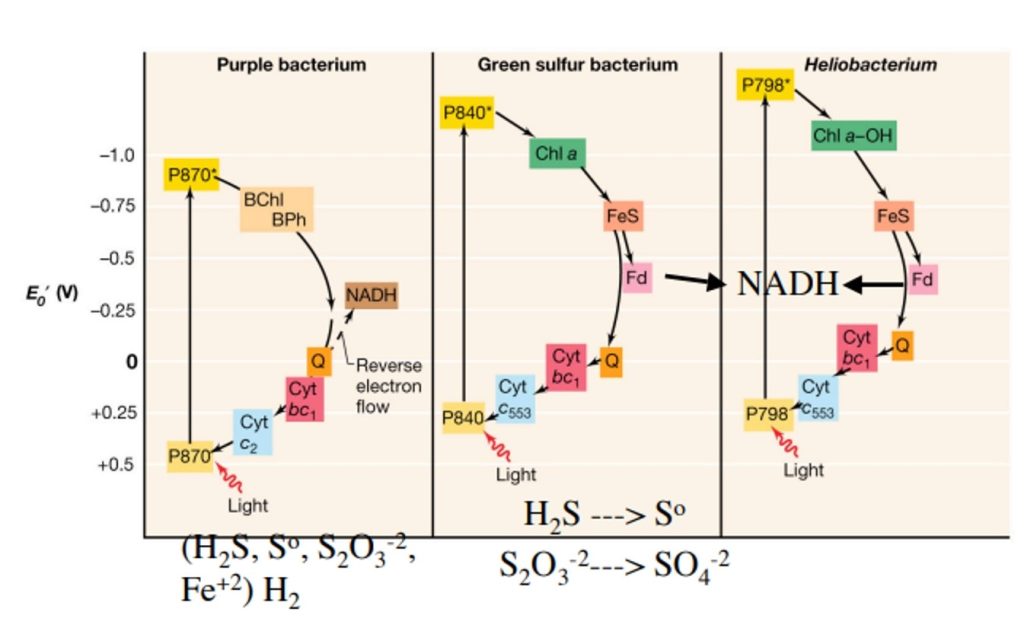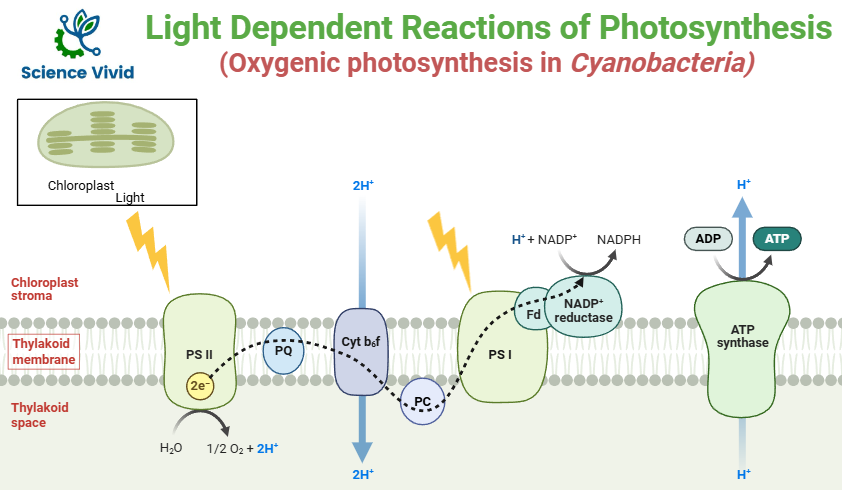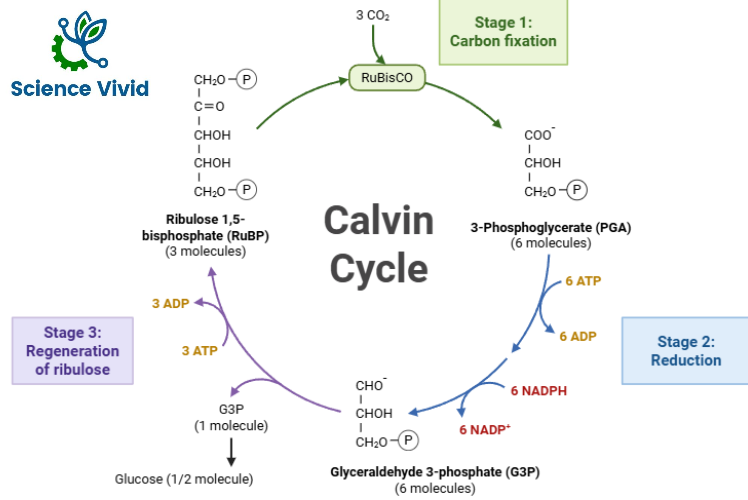Introduction to Photosynthesis:
Plants and other living things employ a process called photosynthesis to change light energy into chemical energy that can subsequently be released in energy transformation. In order to create carbohydrates and other organic compounds from CO2 and H2O, photosynthetic organisms absorb solar energy and convert it into ATP and NADPH.
Phases of Photosynthesis:
Photosynthesis comprises two different phases i.e., Light reaction and Dark reaction.
Light reaction
In the light reactions, photosynthetic cells’ pigments, such as chlorophyll, receive light energy and store it as ATP and NADPH while also producing O2.
An electron in the chromophore is raised to a higher energy level when a photon is absorbed. When the excitation energy of an excited molecule is transferred directly to a nearby molecule, the excited molecule decays to the stable ground state. The remaining pigment molecules in a photosystem are known as antenna or light-harvesting molecules. They quickly and efficiently transfer light energy to the response center after it has been absorbed. With one of two broad types of reaction centers, photosynthetic bacteria have very simple phototransduction machinery.
The Pheophytin-Quinone Reaction Center (Type II Reaction Center)
With one of two broad types of reaction centers, photosynthetic bacteria have very simple phototransduction machinery. The Type II Reaction Center, or Pheophytin-Quinone Reaction Center: The cytochrome bc1 electron transfer complex, an ATP synthase, and a single reaction center (P870) make up purple bacteria’s photosynthetic apparatus. Electrons are driven by light energy through a quinone and pheophytin to the cytochrome bc1 complex, after which they return to the reaction center via cytochrome c2. The cytochrome bc1 complex uses the energy from this light-driven cyclic flux of electrons to pump protons.
By proton gradient, ATP synthase produces ATP. A pair of bacteriochlorophylls— (Chl)2—is the site of the initial photochemistry in the bacterial reaction center. Pheophytin receives an electron from the (Chl)2 donor. This results in the production of two radicals: the pheophytin, which is negatively charged, and the unique pair of chlorophylls, which is positively charged. Now that the pheophytin has transferred its electron to a quinone molecule that is tightly attached (QA), it transforms into a semiquinone radical, which promptly transfers its additional electron to quinone that is loosely bound (QB). Two of these electron transfers change QB into QBH2, its fully reduced form, which can freely diffuse out from the reaction site in the membrane bilayer.
The hydroquinone (QBH2) travels to the cytochrome bc1 complex after entering the pool of reduced quinone (QH2) dissolved in the membrane. The purple bacteria’s cytochrome bc1 complex uses the energy of electron transfer to pump protons across the membrane, creating a proton motive force, after transporting electrons from a quinol donor (QH2) to an electron acceptor. The electron-depleted form of P870 is the ultimate electron acceptor in purple bacteria.
Cytochrome c2, a soluble c-type cytochrome, transports electrons from the cytochrome bc1 complex to P870. The Type I Reaction Center, or Fe-S Reaction Center, is: A cytochrome bc1 electron transfer complex, an ATP synthase, and a single reaction center (P840) make up the photosynthetic apparatus of green bacteria. In the bacterial reaction center, the first photochemistry takes place in chlorophyll a (Chl a). A quinone carrier carries an electron from the reaction center P840 to the cytochrome bc1 complex, where it cycles back to the reaction center via Cyt c553.
Proton transport and the proton-motive force required for ATP production are powered by electron transfer via this complex. Here, some electrons move from the reaction center to ferredoxin, a protein found in the Fe-S, which subsequently transfers electrons from NAD reductase to NAD+, generating NADH. The oxidation of H2S to elemental S and subsequently to SO42-replaces the electrons removed from the reaction center to reduce NAD+

Fig: Anoxygenic photosynthesis in different bacteria
Light reaction in oxygenic life
All bacteria except Cyanobacteria rely on anoxygenic photosynthesis while Cyanobacteria and green plants operate oxygenic photosynthesis which comprises of two photosystems called photosystem I and Photosystem II. Photosystem I is P700 and Photosystem II is P680. In Cyanobacteria, photosynthetic membrane is arranged in stacks within the cytoplasm. It utilizes light to generate both ATP and NADPH and the electrons for NADPH is made by splitting water into oxygen and electrons. The path of electron follows Z scheme of photosynthesis. The light splits water into oxygen and electrons. Light energy converts P680 into strong reductant that reduces Pheophytin a. The electron from water is then donated to oxidized P680 and the electron moves from P680 to QA, QB, Quinone pool and cyt bf to Plastocyanin. The electron is then accepted by reaction center of PSI, P700 which had previously donated electrons that leads to NADPH formation by NADP+ reduction. Cyt bf is the connecting point of two photosystems. In the meantime, while movement of electrons from PSII to PSI occurs, noncyclic ATP synthesis occurs by the virtue of proton motive force generated in the process.

Fig: Oxygenic photosynthesis in Cyanobacteria
Dark Reaction (Calvin Cycle) Light independent reaction
Now that the raw materials for biosynthesis are present, the organisms plan for biosynthesis in a phase called dark reaction which is also a part of photosynthesis. The carbon atoms needed for the manufacture of cellulose and starch, lipids and proteins, and the numerous other organic components of plant cells can be obtained from CO2 by plants and other autotrophs.
Calvin cycle is the path of choice for oxygenic photoautotrophs that produces ATP and NADPH in light reaction as for Calvin cycle, NADPH, Ribulose bisphosphate carboxylase(RubisCO) and phosphoribulokinase is vital.
The first stage in absorbing CO2 into biomolecules is the condensation of six CO2 molecules with twelve 5-carbon acceptors, ribulose 1,5-bisphosphate, to produce twelve molecules of 3phosphoglycerate. In the second stage, the 3-phosphoglycerate is reduced to 12 molecules of glyceraldehyde 3 phosphate using 12 moles of ATP and 12 NADPH.
In the third stage, ten of the 12 molecules of triose phosphate are used to regenerate six molecules of ribulose 1,5-bisphosphate, the starting material with consumption of 6 moles of ATP. The remaining six carbon molecule of triose phosphates, can be used to make fructose for fuel and building materials, sucrose for transport to non-photosynthetic tissues, or starch for storage.

Fig: Dark Reaction (Calvin Cycle)
References:
- Axelrod HL, Abresch EC, Okamura MY, Yeh AP, Rees DC, Feher G. X-ray structure determination of the cytochrome c2: reaction center electron transfer complex from Rhodobacter sphaeroides. J Mol Biol. 2002 May 31;319(2):501-15. doi: 10.1016/S0022-2836(02)00168-7. PMID: 12051924
- Kushkevych, I., Procházka, V., Vítězová, M., Dordević, D., & Rittmann, S. K. (2024). Anoxygenic photosynthesis with emphasis on green sulfur bacteria and a perspective for hydrogen sulfide detoxification of anoxic environments. Frontiers in Microbiology, 15, 1417714. https://doi.org/10.3389/fmicb.2024.1417714
- Rögner M, Boekema EJ, Barber J. How does photosystem 2 split water? The structural basis of efficient energy conversion. Trends Biochem Sci. 1996 Feb;21(2):44-9. doi: 10.1016/s0968-0004(96)80177-0. PMID: 8851657
- Springett R. The proton pumping mechanism of the bc1 complex. Biochim Biophys Acta Bioenerg. 2021 Mar 1;1862(3):148352. doi: 10.1016/j.bbabio.2020.148352. Epub 2020 Dec 16. PMID: 33338489
